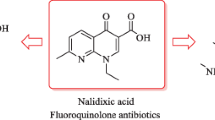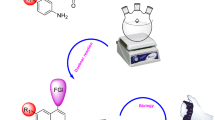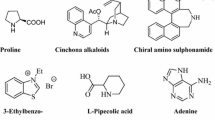Abstract
New azetidinone and thiazolidinone class of bioactive agents based on quinoline nucleus have been synthesized. 2-Chloroquinoline-3-carbaldehyde reacted with various substituted amine to form the corresponding Schiff base intermediates. We have derived final azetidinone and thiazolidinone analogues from Schiff bases using chloroacetyl chloride and 2-mercaptoacetic acid, respectively. The newly synthesized analogues were then examined for their antimicrobial activity against some bacterial and fungal strains as two gram −ve bacteria (Escherichia coli MTCC 739 and Pseudomonas aeruginosa MTCC 741), two gram +ve bacteria (Staphylococcus aureus MTCC 96 and Bacillus subtilis MTCC 430), two fungal species (Aspergillus niger MTCC 282 and Candida albicans MTCC 183) as well as against Mycobacterium tuberculosis strain H37Rv to develop a novel class of bioactive agents. The results of bioassay showed that some of the newly synthesized azetidinones and thiazolidinones emerged as lead molecules with excellent MIC (mg/mL) values against mentioned microorganisms compared to standard drugs. The structure of the final analogues has been confirmed on the basis of IR, 1H NMR, 13C NMR, and elemental analysis.


Similar content being viewed by others
References
Bhat IK, Mishra SK, James JP, Shastry CS (2011) Antimicrobial studies of synthesized azetidinone derivatives from sulfamethoxazole moiety. J Chem Pharm Res 3(3):114–118
Bhati SK, Kumar A (2008) Synthesis of new substituted azetidinoyl and thiazolidinoyl-1,3,4-thiadiazino (6,5-b) indoles as promising anti-inflammatory agents. Eur J Med Chem 43:2323–2330
Desai NC, Dodiya AM, Shihora PN (2011) A clubbed quinazolinone and 4-thiazolidinone as potential antimicrobial agents. Med Chem Res. doi:10.1007/s00044-011-9674-5
Donnell FO, Smyth TJP, Ramachandran VN, Smyth WF (2010) A study of the antimicrobial activity of selected synthetic and naturally occurring quinolines. Int J Antimicrob Agents 35(1):30–38
Dua R, Sonwane SK, Srivastava SK, Srivastava SD (2010) Greener and expeditious synthesis of 2-azetidinone derivative from 2-mercaptobenzothiazole and their pharmacological screening of the synthesized compounds using microwave irradiation. World J Chem 5(1):52–56
Gillespie SH (1994) Medical microbiology—illustrated. Butterworth Heinemann Ltd, Oxford, p 234
Halve AK, Bhadauria D, Dubey R (2007) N/C-4 substituted azetidin-2-ones: synthesis and preliminary evaluation as new class of antimicrobial agents. Bioorg Med Chem Lett 17:341–345
Hawkey PM, Lewis DA (1994) Medical bacteriology—a practical approach. Oxford University Press, Oxford, p 181
Isenberg HD (1992) Clinical microbiology procedures handbook, vol 1. American Society for Microbiology, Washington, DC
Kumar A, Rajput CS, Bhati SK (2007) Synthesis of 3-[40-(p-chlorophenyl)-thiazol-20-yl]-2-[(substituted azetidinone/thiazolidinone)-aminomethyl]-6-bromoquinazolin-4-ones as anti-inflammatory agent. Bioorg Med Chem 15:3089–3096
Levy S, Azoulay S (1994) Stories about the origin of quinquina and quinidine. J Cardiovasc Electrophysiol 5(7):635–636
Makawana JA, Patel MP, Patel RG (2011) Synthesis and in vitro antimicrobial evaluation of pentasubstituted pyridine derivatives bearing the quinoline nucleus. Med Chem Res. doi:10.1007/s00044-011-9568-6
Meth-Cohn O, Bramha NA (1978) A versatile new synthesis of quinolines, thienopyridine and related fused pyridines. Tetrahedron Lett 23:2045–2048
Mungra DC, Patel MP, Patel RG (2010) Microwave-assisted synthesis of some new tetrazolo [1,5-a]quinoline-based benzimidazoles catalyzed by p-TsOH and investigation of their antimicrobial activity. Med Chem Res. doi:10.1007/s00044-010-9388-0
Pareek D, Chaudhary M, Pareek PK, Kant R, Ojha KG, Pareek R, Pareek A (2011) Synthesis and biological evaluation of 4-thiazolidinone derivatives incorporating benzothiazole moiety. Pharm Sinica 2(1):170–181
Patel NB, Patel SD (2010) Synthesis and antimicrobial study of fluoroquinolonebased 4-thiazolidinones. Med Chem Res 19:757–770
Pawar RB, Mulwad VV (2004) Synthesis of some biologically active pyrazole, thiazolidinone, and azetidinone derivatives. Chem Heterocycl Compd 40(2):219–226
Rajasekaran A, Periasamy M, Venkatesan S (2010) Synthesis, characterization and biological activity of some novel azetidinones. J Dev Biol Tissue Eng 2(1):5–13
Rokade Y, Dongare N (2010) Synthesis and antimicrobial activity of some azetidinone derivatives with the β-naphthol. Rasayan J Chem 3(4):641–645
Ross NA, MacGregor RR, Bartsch RA (2004) Synthesis of b-lactams and b-aminoesters via high intensity ultrasound-promoted Reformatsky reactions. Tetrahedron 60:2035–2041
Shingade SG, Bari SB, Waghmare UB (2011) Synthesis and antimicrobial activity of 5-chloroindoline-2,3-dione derivatives. Med Chem Res. doi:10.1007/s00044-011-9644-y
Wang Y, Zhang H, Huang W, Kong J, Zhou J, Zhang B (2009) 2-Azetidinone derivatives: design, synthesis and evaluation of cholesterol absorption inhibitors. Eur J Med Chem 44:1638–1643
Wenckebach KF (1923) Cinchona derivatives in the treatment of heart disorders. J Am Med Assoc 81(6):472–474
Acknowledgments
The authors are thankful to Applied Chemistry Department of S. V. National Institute of Technology, Surat for the scholarship, encouragement and facilities. The authors wish to offer their deep gratitude to Centre of Excellence, Vapi, India for carrying out 1H NMR and 13C NMR analysis.
Author information
Authors and Affiliations
Corresponding authors
Rights and permissions
About this article
Cite this article
Mistry, B.M., Jauhari, S. Quinoline-based azetidinone and thiazolidinone analogues as antimicrobial and antituberculosis agents. Med Chem Res 22, 647–658 (2013). https://doi.org/10.1007/s00044-012-0061-7
Received:
Accepted:
Published:
Issue Date:
DOI: https://doi.org/10.1007/s00044-012-0061-7




